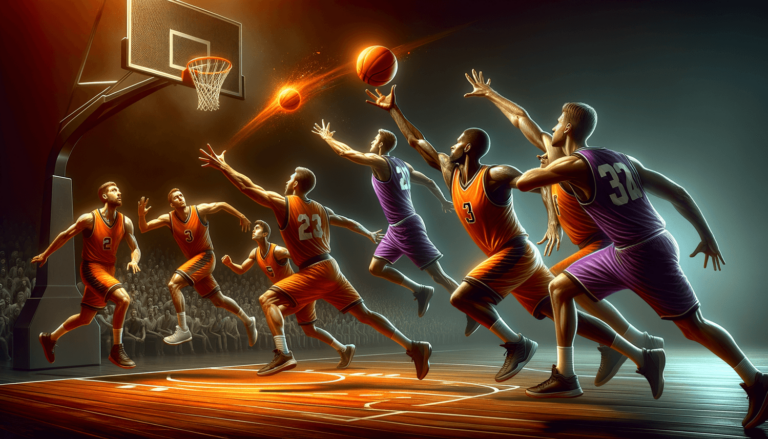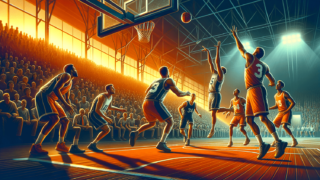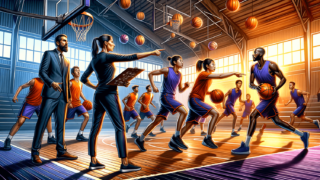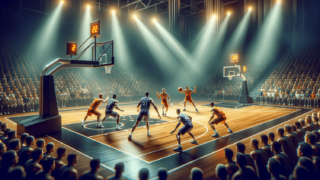
Get ready to dive into the exciting world of basketball strategies as we unravel the mysteries of the 2-1-2 half-court press! The 2-1-2 half-court press is a defensive tactic that puts pressure on the offensive team, disrupting their rhythm and forcing turnovers. This formidable strategy has been employed by countless coaches over the years, ranging from youth teams to professional organizations. Whether you’re an aspiring coach searching for innovative ways to improve your team’s performance, or simply a basketball enthusiast yearning to deepen your understanding of the game, this blog post will give you an insight into the fast-paced drama that unfolds whenever the 2-1-2 half-court press is in play. So tighten your laces, it’s going to be an exhilarating ride!
What’s a 2-1-2 Half-Court Press in Basketball?
A 2-1-2 half-court press is a defensive basketball strategy where a team’s defensive players are positioned in a 2-1-2 formation across the half-court line. The main objective is to apply pressure on the opposing team’s ball handler, disrupt the offensive flow, and force turnovers. This is achieved by trapping the offensive players in zones, preventing easy passes, and aggressively challenging any attempts to advance the ball towards the basket.
Unraveling the Components of the 2-1-2 Half-Court Press
Mastering the 2-1-2 half-court press begins with understanding its various components. It’s a versatile defensive strategy that’s adaptable to different situations, while primarily focusing on disrupting the offense’s flow, ball movement, and shooting opportunities. Let’s break down the key elements of this dynamic game plan and explore how you can use it to your advantage on the basketball court.
Player Positioning and Roles
A 2-1-2 formation consists of five players, positioned to form a structured, yet flexible defense. Here’s a breakdown of the lineup:
- Two Guards (Front Line): These players are responsible for applying on-ball pressure and trapping opponents around the half-court line. Positioned on either side of the court, they need to be agile, fast, and skilled in reading the game.
- One Forward (Middle Line): This player patrols the center part of the half-court and helps with trapping situations. They should be tall and athletic, ready to challenge and deflect passes.
- Two Post Players (Back Line): The two post players provide support from the paint area and are responsible for shutting down open lanes, rebounding, and contesting shots. They usually have good size and shot-blocking abilities.
Defensive Pressure and Trapping
Once the players are in position, they work together to apply defensive pressure and create trapping situations. The front line guards will approach the ball handler, funneling them to a sideline or baseline. Utilizing their quickness and agility, the guards aim to close off escape routes and force the offensive player to make panicked decisions.
Next, the middle line forward swoops in to cut off passing lanes, forcing the ball handler into a trap. This coordinated effort is the key to the success of the 2-1-2 half-court press, aiming to force bad passes or turnovers.
Zoning and Breakdowns
While the 2-1-2 half-court press relies on man-to-man principles, it also integrates elements of zone defense by dividing the court into specific areas of responsibility. Players must cover their designated zones while maintaining tight defensive pressure, making it hard for opponents to pass or move the ball.
It’s crucial to have reliable communication among players to prevent breakdowns in the defensive structure. Fast and accurate decision-making is essential; a lapse in concentration or communication could lead to opponents finding openings and scoring opportunities.
Implementing the 2-1-2 Half-Court Press: Drills and Techniques
To fully harness the power of the 2-1-2 half-court press, it’s necessary to practice various drills and techniques that reinforce critical skills and coordination among players.
1. Closeout Drills
Closeout drills are designed to improve a player’s ability to quickly transition from help defense to on-ball defense. These drills help develop proper footwork and defensive habits, contributing significantly to the overall effectiveness of the 2-1-2 half-court press.
2. 2v2 and 3v3 Half-Court Games
Smaller-sided games, such as 2v2 and 3v3 half-court games, help develop decision-making skills, on-ball pressure, and trapping principles. Players must work together to create double-team situations and block passing lanes, essential components of the 2-1-2 half-court press.
3. Shell Drill
The shell drill focuses on building communication and rotation skills within the defensive system. Players will learn to slide, rotate, and close out efficiently, essential for maintaining a cohesive defensive structure in the 2-1-2 half-court press.
Adjusting the 2-1-2 Half-Court Press for Different Opponents
One of the greatest benefits of the 2-1-2 half-court press is its versatility. It can be adapted according to the strengths and weaknesses of both your team and the opposition. The key lies in identifying these unique qualities and using them to inform your tailored game plan.
Countering Quick and Agile Ball Handlers
If the opposing team has quick and agile ball handlers capable of maneuvering through pressure, consider extending the pressure of the front line guards up the court. This adjustment can help disrupt forward progress and facilitate trapping scenarios earlier in the possession.
Dealing with Sharp Shooters
If facing a team with accurate shooters, emphasize closing out on shooters aggressively by utilizing fast rotations and effective communication among the defensive players. Quick closeouts on shooters can force them out of their comfort zone, reducing their shooting efficiency.
Neutralizing Strong Inside Scorers
When dealing with teams that are proficient inside scorers, it’s important to collapse the back line post players towards the paint. This adjustment provides help defense against post plays and drives to the basket, while guards and forwards remain cautious of open shooters.
Great Examples of the 2-1-2 Half-Court Press in Action
Looking for inspiration to fuel your foray into the world of the 2-1-2 half-court press? Here are some notable examples from basketball history that showcase the strategy’s power and effectiveness:
- The “Havoc” Defense: Legendary coach Shaka Smart implemented a version of the 2-1-2 half-court press called “Havoc” during his tenure at Virginia Commonwealth University (VCU). With an emphasis on constant pressure, the tactic led VCU to multiple NCAA tournament upsets and a Final Four appearance in 2011.
- The Boston Celtics in the 1980s: The formidable Boston Celtics of the 1980s, led by Larry Bird, frequently used the 2-1-2 half-court press in crucial moments. Their strategic prowess and execution helped them secure multiple championships during this era.
The beauty of basketball lies in the strategic innovations introduced by talented coaches and players. The 2-1-2 half-court press is just one of many unique strategies that continue to challenge opponents and elevate the sport’s competitive landscape. As you practice and develop your understanding of the 2-1-2 half-court press, remember that success comes from team synergy, adaptability, and constant improvement. Good luck, and enjoy the strategic complexities of the basketball world!
Maximizing Your Team’s Strengths in the 2-1-2 Half-Court Press
To excel with the 2-1-2 half-court press, it’s vital to recognize and maximize your team’s strengths. These five key areas can help optimize your players’ capabilities and overall team performance when using this strategy:
1. Speed and Agility
Having quick and agile players on your team can greatly enhance your team’s 2-1-2 half-court press. Fast guards and forwards can effectively trap ball handlers while getting back into the defensive structure, ensuring the press remains fluid and unpredictable.
2. Size and Physicality
Emphasizing size and physicality creates more challenging traps, alters opponents’ shots by contesting more effectively, and intimidates drivers. Exploiting this advantage can boost your team’s defensive efficiency and help secure more victories.
3. Communication and Teamwork
Ensure your team communicates effectively both on and off the court. Effective communication is vital to the success of the 2-1-2 half-court press, as players need to stay in sync, execute traps, and avoid defensive breakdowns.
4. Anticipation and Reading the Game
Players adept at anticipating offensive moves are crucial when using the 2-1-2 half-court press. Those with exceptional basketball instincts can successfully bait opponents into bad passes, generate turnovers, and create fast-break opportunities.
5. Conditioning and Stamina
The 2-1-2 half-court press requires intense physical exertion and high stamina levels. To maintain an efficient press throughout the game, your players must be in top physical condition. Focus on stamina and conditioning exercises to optimize your performance when executing this strategy.
Dealing with Common Challenges in the 2-1-2 Half-Court Press
While the 2-1-2 half-court press is a formidable defensive strategy, it’s only natural to face occasional challenges when employing it. Here’s a discussion of some common issues and how to address them:
1. Overcommitting to Traps
When executing the 2-1-2 half-court press, it’s crucial to strike the right balance between aggressive traps and maintaining defensive structure. A common issue is overcommitting to traps, leaving gaps and vulnerabilities for skilled offensive teams to exploit. Adjust your trapping intensity to maintain a cohesive defense while still applying pressure and forcing turnovers.
2. Struggling with Rotations
Effective rotations are a cornerstone of the 2-1-2 half-court press. If your team is struggling with timely and accurate rotations, focus on communication and emphasize the importance of understanding the press’s structure. This awareness will enable smoother transitions between traps and prevent opponents from scoring easy points.
3. Identifying Vulnerabilities in the Press
Like any good strategy, the 2-1-2 half-court press has its weaknesses. Recognizing these vulnerabilities can help your team shore up its defense and better anticipate how opposing teams will attempt to exploit them. Be prepared to adapt your press execution to counterbalance any perceived weak points.
By cultivating your team’s strengths and addressing common challenges, the 2-1-2 half-court press can become a powerful weapon in your basketball arsenal. Remember, basketball is a dynamic game that rewards teams that adapt, think strategically, and continually work to improve their skills. Embrace the challenge of mastering the 2-1-2 half-court press and enjoy the thrill of competition!
Frequently Asked Questions
It’s no surprise that readers may have more questions about the strategic intricacies of the 2-1-2 half-court press. In this helpful FAQ section, we’ve compiled a list of common inquiries and provided concise, NLP-style answers to satisfy your basketball curiosity.
1. How effective is the 2-1-2 half-court press at generating turnovers?
When executed well, the 2-1-2 half-court press can be highly effective at generating turnovers by applying constant pressure on the offense, disrupting their rhythm, and forcing bad passes.
2. Who are the key players in the 2-1-2 half-court press?
All five players are crucial, as this strategy relies on teamwork and coordination. However, front-line guards and the middle line forward are particularly important, as they initiate traps and disrupt passing lanes.
3. Can the 2-1-2 half-court press be used for an entire game?
Using the 2-1-2 half-court press for an entire game can be physically demanding, so it’s often reserved for specific situations or segments in a match. However, well-conditioned teams may employ it more extensively.
4. How does the 2-1-2 half-court press differ from a zone defense?
The 2-1-2 half-court press is a hybrid strategy that includes elements of both man-to-man and zone defense principles. While it focuses on pressuring the offense, it also assigns specific zones of responsibility for each player.
5. Is the 2-1-2 half-court press suitable for youth basketball teams?
Yes, the 2-1-2 half-court press can be employed by youth teams, as it promotes teamwork, communication, and defensive awareness. The fundamentals of this strategy can benefit players as they progress through different levels of competition.
6. How do I handle opposing teams that can break the press?
If an opponent consistently breaks your press, consider adjusting defensive pressure, player positioning, and trapping intensity. Be prepared to make tactical changes or even switch to an alternative defensive strategy if needed.
7. Is the 2-1-2 half-court press easy to learn?
While the 2-1-2 half-court press may initially seem complex, it can be learned and implemented effectively with practice and a strong understanding of the strategy’s principles. Coaching, drills, and team coordination are essential to grasping this defensive tactic.
8. How can I improve my team’s execution of the 2-1-2 half-court press?
Improving the execution of the 2-1-2 half-court press starts with clearly defining roles, practicing drills to hone skills, enhancing communication, and focusing on individual player development. Periodic adjustments and analysis of game tape can also help identify areas for improvement.
9. Can the 2-1-2 half-court press be used in combination with other defenses?
Yes, the 2-1-2 half-court press can be combined with other defensive strategies, such as zone or man-to-man defenses. By varying your tactics, you can keep the opposing team off-balance and adapt to different game situations.
10. What types of teams benefit most from using the 2-1-2 half-court press?
Teams with quick, athletic, and well-conditioned players who excel in communication, anticipation, and teamwork are more likely to benefit from the 2-1-2 half-court press. The key to success is the effective synergy of these vital skills.
Featured Posts
- No pillar pages found.





